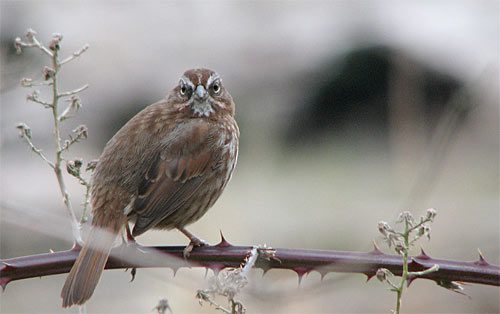Young Sparrows Learn by Eavesdropping
By Hugh Powell
October 21, 2009

Birdsong fascinates scientists because it’s varied, beautiful, complicated—and because many birds learn songs in a way similar to how humans learn language. Studying the way young birds acquire their songs might allow us to solve problems with the way children develop language.
Much song research is done by watching young birds in captivity, but research just published today tackled the formidable task of following birds through field and forest. The approach gave the researchers a more realistic picture of how young birds behave. The scientists, led by grad student Chris Templeton of University of Washington, discovered that juvenile Song Sparrows are more interested in listening to two adult male Song Sparrows sing at each other than in listening to just one. That’s an exciting finding, because it suggests that the young birds don’t just mimic the sounds of a single adult. They listen to the way the two birds trade song phrases and types back and forth, perhaps learning the appropriate context for each phrase, or at least learning which song types are the most common in their neighborhood.
The researchers get extra points for effort. They set up experiments in a large, wild park in Seattle. Since they weren’t working with caged birds, they attached tiny radio-transmitters to 11 juvenile Song Sparrows so they could keep tabs on their whereabouts. In a series of experiments, speakers set up near each bird played the sound of either one adult Song Sparrow, two adult Song Sparrows singing at each other, or, as controls, the sounds of one or two Black-capped Chickadees. As the sounds played, the researchers kept close track of the young Song Sparrow’s actions. They found that the birds moved much closer to the speaker when it played two Song Sparrows than with any other recording. Their response to a single Song Sparrow wasn’t much different from their response to chickadee recordings—essentially mild curiosity rather than the keen interest they had in two birds conversing.
The research is only a few hours old, but it’s already appeared in a number of news outlets. Several of the stories tout the finding that young sparrows learn their songs, but what’s really exciting here is their interest in eavesdropping on an adult “conversation.” When people first started studying birdsong we thought of birds as tiny tape recorders that heard a song, then reproduced it as best it could. In the decades since then we’ve gradually seen how much learning and even improvising (in the case of mockingbirds, for example) goes on. Now it seems that even in their first few months of life, Song Sparrows are attuned not only to sound, but to social interactions that, as adults, they will have to navigate using their voices.
Hear more Song Sparrows and see videos on All About Birds.
(Full disclosure: I knew Chris Templeton in grad school about 10 years ago, when he was a Master’s student working with chickadees. Way to go Chris!)


All About Birds is a free resource
Available for everyone,
funded by donors like you





